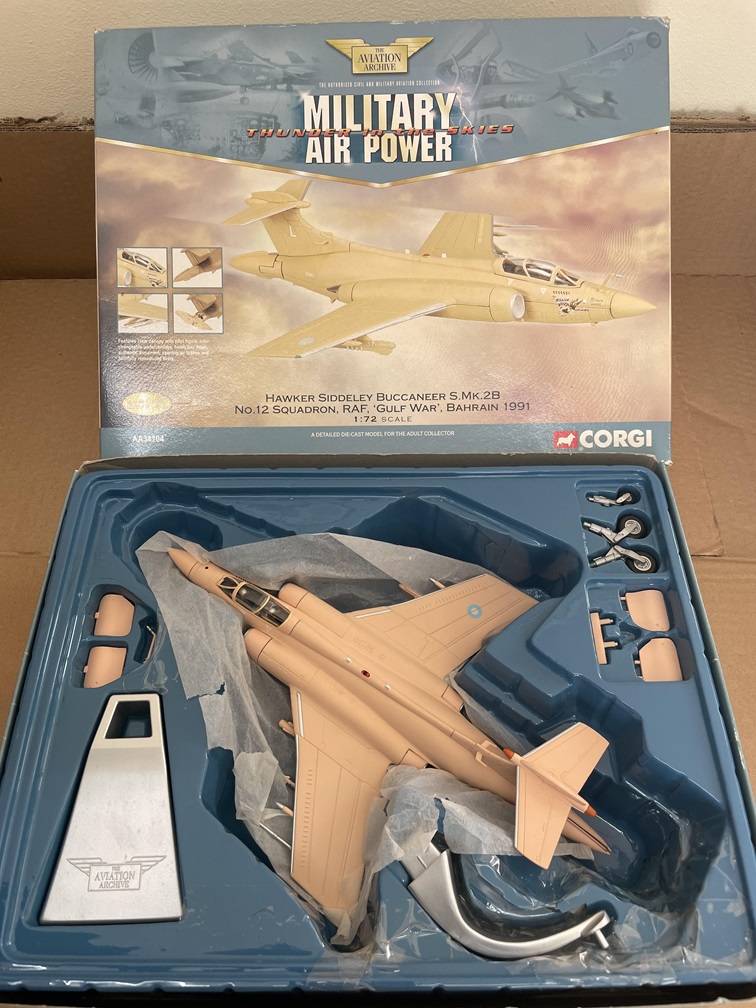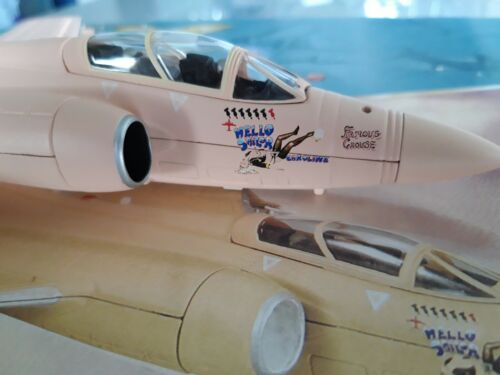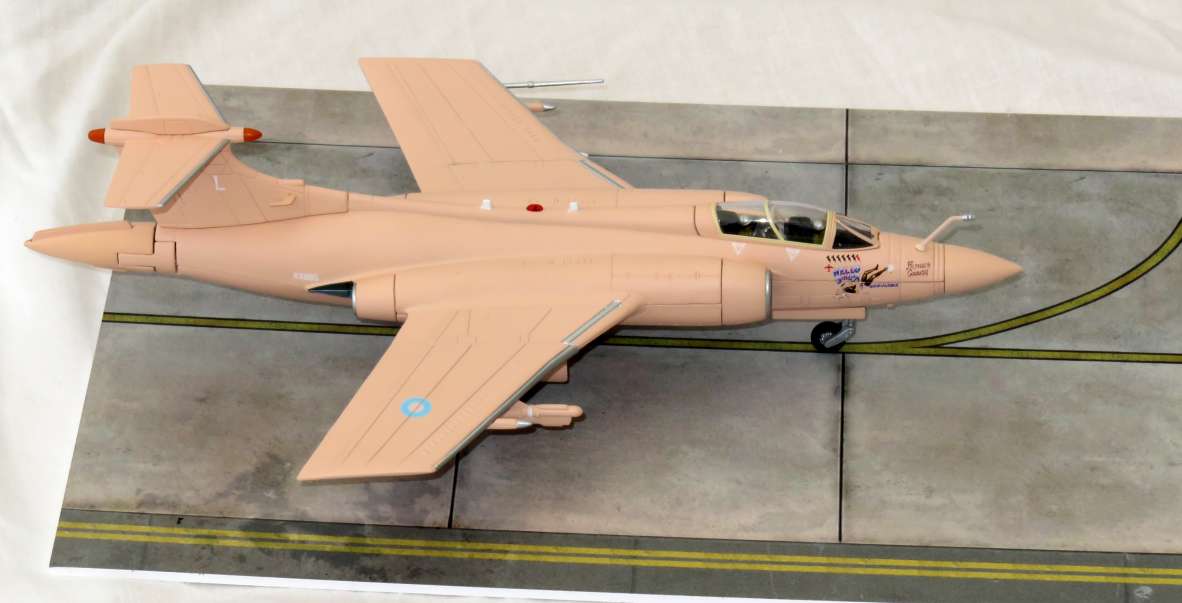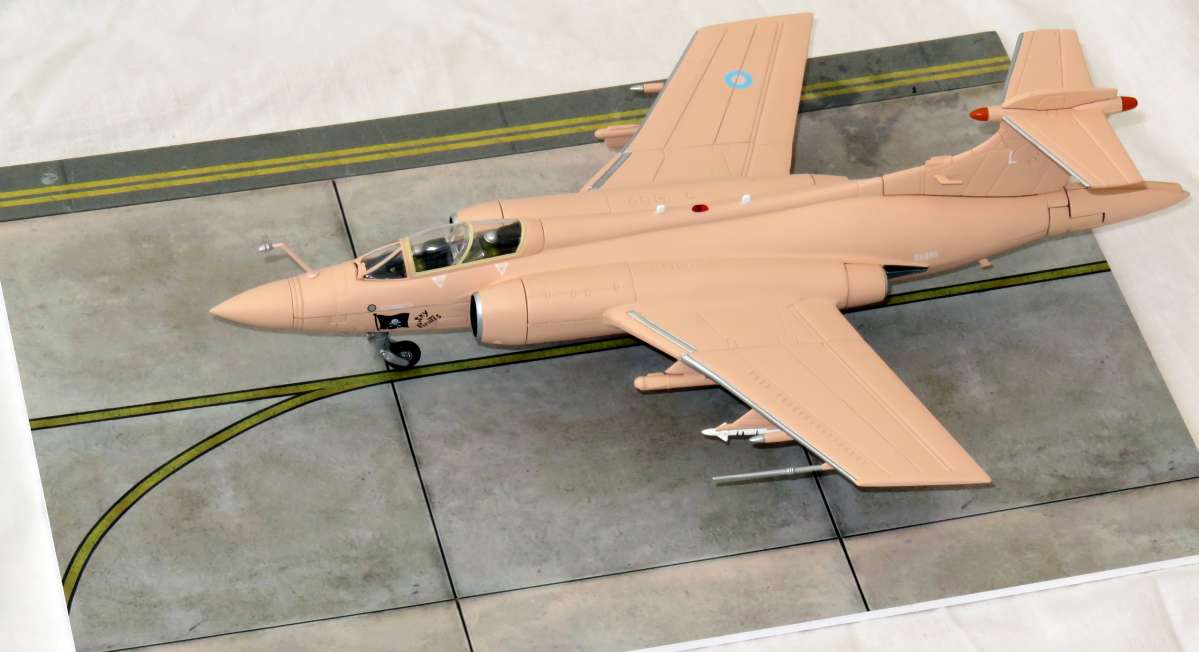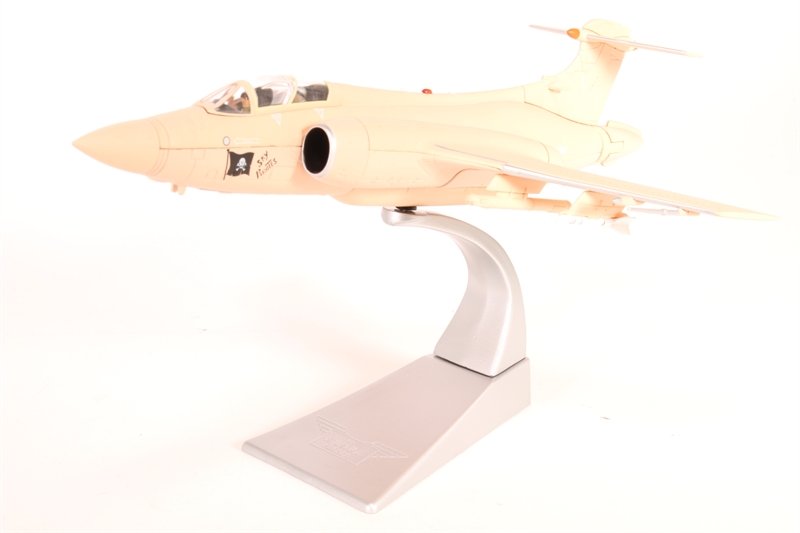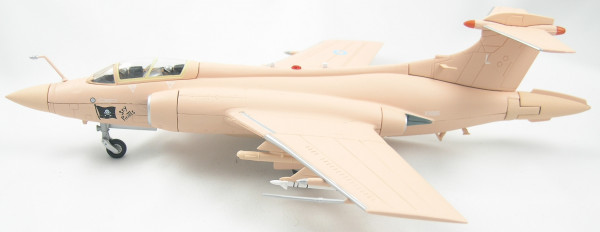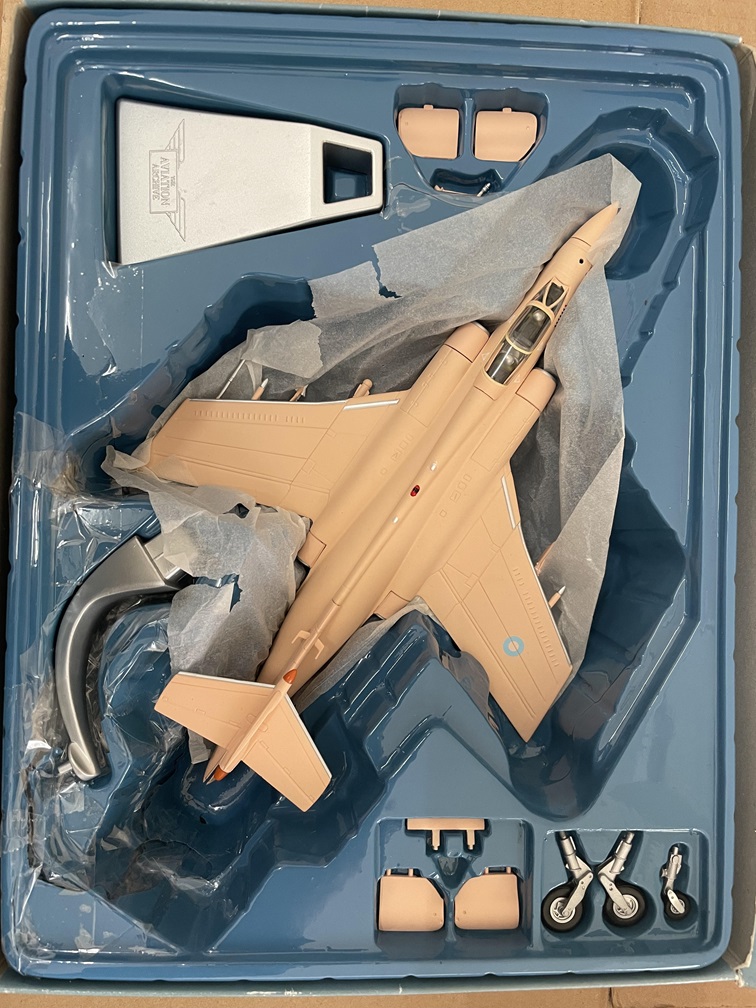Hawker Siddeley Buccaneer S2B – 12 Sqn RAF, Gulf War, Bahrain 1991 (Preserved) Damaged Box
Add to compare1 in stock
£59.99
1 in stock
Corgi Aviation Archive 1/72 scale AA34104: Hawker Siddeley (HS) Buccaneer S2B XX885 of 12 Squadron RAF in the colours it wore during the first Gulf War in Feb 1991. Includes artwork adorned by the ground-crew: “Sky Pirates” on the nose port side and “Hello Sailor Caroline” and “Famous Grouse” on the starboard side. With excellent detail including opening airbrakes, armament, optional undercarriage positions and authentic livery. Limited edition of 3,900 models.
Length 10.5 inches Wingspan 7.25 inches
PLEASE NOTE: Box trays are notoriously flimsy on this model. Blue plastic tray has shattered and been put back together with sellotape and bubble wrap used to cushion the underside. The triangular skid which is an optional fit to the underside rear is missing. Otherwise a superb model
XX885 was delivered to the RAF on May 20th 1974 and went on to serve with 15 and 16 Sqn based at Laarbruch in Germany, before being transferred to 12Sqn at Lossiemouth, and stayed here until 1980. Due to the incident of Buccaneer XV345 during operation Red Flag, the fleet was temporarily grounded. When investigations showed that the main spar in XV345 had failed, like many others, XX885 was flown to St Athan for a main spar replacement, and then returned to 12 Sqn. She also went on to serve with 208 Sqn and 237 OCU at Lossiemouth. In January 1991, she was prepared for the Gulf War, being painted in overall Alkali Removable Temporary Finish (ARTF), more commonly known as ‘desert pink’. XX885 was given the tail code ‘L’, named ‘Famous Grouse’, and given the nose art – ‘Caroline, Hello Sailor’. During the Gulf, she earned 7 mission symbols, of which one included the AN-12 symbol. The AN-12 symbol actually belongs to Buccaneer XX894 from when she bombed an AN-12. XX885 was on the same mission and after landing had parked in XX894s spot, resulting in XX885 receiving the AN-12 and getting all the credit. XX885 has the latest modifications out of the entire fleet due to being the last Buccaneer to go through Woodford in 1989, and she then received further modifications for the Gulf War.
XX885 retired in 1994 to Lossiemouth where she was to become a maintenance airframe. Although she was given the number 9225M she was never used for instructional uses, but was instead put in storage on-site undercover. In 2000, the RAF put XX885 up for disposal with Hawker Hunter Aviation (HHA) purchasing her at an auction in March of that year. The airframe was moved to HHAs facility at RAF Scampton with a small vision of possibly getting it airworthy again. She’s complete, always been undercover, never dismantled, and has no corrosion. Nearly 3000 hours of analysis work went into her which included, a complete IRAN (Inspect & Repair as Necessary) was concluded by HHA engineers in 2003 on the entire airframe and all subsystems. Custodial maintenance and ground runs were carried out on a very regular basis as per the maintenance schedules. Airframe and engine hours were good, the AP library was complete, they have acquired and overhauled a complete set of Bucc GSE also acquired, inspected, catalogued, overhauled and stored a considerable number of Buccaneer spares amongst which was the entire Bucc. spares pack from RAE Bedford, an organisation which like HHA operated a single Buccaneer away from normal squadron support. These stores include 2 spare engines. She was then classified in the BCAR A8-20 ‘Complex’ category for civilian use, and so gained the serial G-HHAA.
This is as far as XX885 ever got to getting airworthy again. The airframe regularly undertook anti-deterioration runs to exercise her systems, however, she rarely taxied, let alone fast taxied. But sadly, this all came to a halt several years ago as there was no interest in getting her flying anymore. The aircraft sat outside for some time before going undercover again in one of the hangars, she hasn’t been run or even hydraulically exercised in going on a decade now, although, she has spent the last few years back undercover again. XX885 (G-HHAA) is far from being in airworthy condition, having not been even exercised in several years!
HHA has no current or future plans for XX885 other than to leave her stored in one of their hangars along with a few Hunters. XX885 is the only complete Buccaneer still wearing the wrap round grey colours which were applied when she arrived back from the Gulf War in 1991.
The Blackburn Buccaneer was a British low-level subsonic strike aircraft with nuclear weapon delivery capability serving with the Royal Navy and the Royal Air Force between 1962 and 1994, including service in the 1991 Gulf War. Designed and initially produced by Blackburn Aircraft at Brough it was later known as the Hawker Siddeley Buccaneer when Blackburn became a part of the Hawker Siddeley group.
The Buccaneer was a mid-wing, twin-engine monoplane with a crew of two seated in tandem under a sliding canopy. To meet the demands of the specification, the Buccaneer featured a number of advanced design features. The fuselage was area ruled; meaning it was designed to reduce drag at transonic speeds. This gives rise to the characteristic curvy “Coke bottle” shape. It featured a variable incidence tailplane that could be trimmed to suit the particular requirements of low-speed handling or high-speed flight. At low levels and high speeds traditional bomb bay doors could not be opened safely into the air stream; therefore, doors were developed that rotated into the fuselage to expose the payload. This configuration was also useful in assisting ground-level access.
The Buccaneer had been designed specifically as a maritime nuclear strike aircraft. Its intended weapon was a nuclear air-to-surface missile codenamed Green Cheese, but this weapon’s development was cancelled, and in its place was the unguided 2,000 pound (900 kg) Red Beard, which had been developed for the Canberra. Red Beard had an explosive yield in the 10 to 20 kiloton range. It was mounted on a special bomb bay door into which it nested neatly to reduce aerodynamic buffet on the launch aircraft. Red Beard was an unsophisticated weapon and had to be armed before takeoff instead of in flight, clearly an undesirable feature.
The bomb bay could also accommodate a 2,000 litre ferry tank, as well as a photo-reconnaissance “crate” or a cargo container. The reconnaissance crate could accommodate a photoflash flare dispenser and up to six cameras, in various configurations of long-range, wide angle, and night vision cameras that could be mounted in vertical, oblique, or (using a blister in the pack) forward-looking orientations. The photoflash unit was rarely used, with the Royal Navy preferring to use the Gloworm rocket, with eight mounted on the Buccaneer’s stores pylons, for night operations.
The cargo container would prove useful for transporting golf clubs and other essentials. There had been plans to develop a bomb bay tanker pack, but the underwing pack proved adequate. There was also a plan for a pack with twin Aden 30 mm cannon, but it was abandoned and the Buccaneer would never carry gun armament.
The small wing of the Buccaneer was suited to high-speed flight at low level. Such a wing, however, did not generate the lift that was essential for carrier operations. Therefore the wing and horizontal stabiliser were “blown” by bleeding compressor gas from the engine through surface vents; this was known as Boundary layer control or BLC, and had the effect of energising and smoothing the boundary layer airflow, which significantly reduced airflow separation at the back of the wing (and therefore decreased stall speed) and increased effectiveness of trailing edge control surfaces including flaps and ailerons. Before landing, the pilot would open the BLC vents as well as lower the flaps to achieve slow, stable flight. A consequence of the blown wing was that the engines were required to run at high power for low-speed flight in order to generate sufficient compressor gas for blowing. Blackburn’s solution to this situation was to provide a large air brake. The tail cone was formed from two leaves that could be hydraulically opened into the airstream to decelerate the aircraft. The nose cone and radar antenna could also be swung around by 180° to reduce the length of the aircraft in the carrier hangar. This feature was particularly important due to the small size of the aircraft carriers that the Buccaneer typically operated from.
During the 1980 Red Flag exercises in America one of the RAF Buccaneers lost a wing due to a fatigue induced crack and crashed, killing its crew. The entire RAF Buccaneer fleet was grounded in February 1980 and investigation discovered serious metal fatigue problems. A total of 60 aircraft were selected to receive new spar rings and the moved to RAF Lossiemouth in the anti-shipping role, armed with Martel missiles.
The Buccaneer was deployed in combat operations during the 1991 Gulf War when 12 examples were rushed to the area to provide a laser designation capability for British aircraft. RAF Tornados attacking with anti-runway munitions were being lost to the large amounts of light anti-aircraft weaponry defending the airfields. As a result attacks changed to attacking from 20,000 ft with guided bombs.
Buccaneers flew 218 missions, both designating for other aircraft and dropping 48 laser-guided bombs themselves. The last Buccaneer missions were on 27 February 1991. On that day a pair of Buccaneers knocked out two Iraqi transport aircraft on the Shayka Mazhar airfield. The last Buccaneers were withdrawn in March 1994 when 208 Squadron disbanded.
| Weight | 1.6 kg |
|---|

